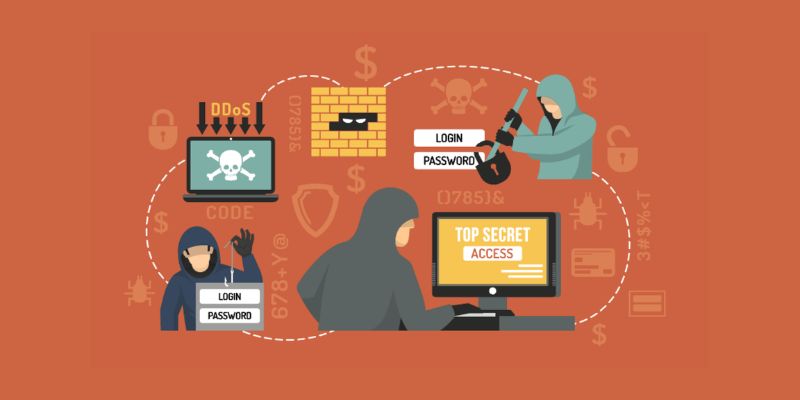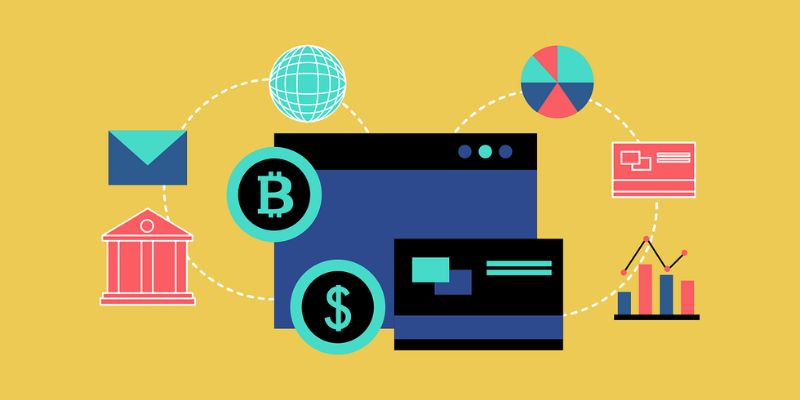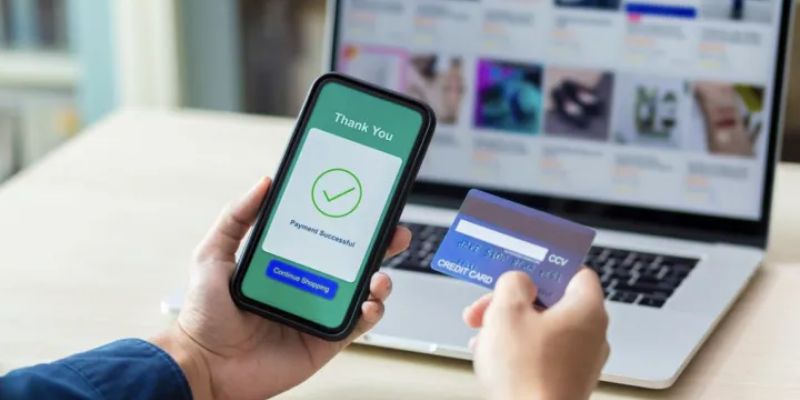Protecting yourself from digital payment fraud is crucial in this online shopping boom. Each click could open a door to scammers eager to grab your hard-earned cash. You shop, you click, and boom – there goes your peace of mind, right? Not on my watch! I’ll arm you with the defenses you need to secure your finances, so you can click with confidence. Let’s dive in and kick fraud to the curb!
Essential Security Measures for Digital Transactions
Implementing Online Payment Security Tips
When buying online, you want to keep your money safe. So, what can you do? Let’s dive into how to protect your hard-earned cash in this digital age. Picture this: You find the perfect gadget online, but first, think safety! Start with a strong password. Not your pet’s name or birthday. Mix letters, numbers, and symbols to lock down your accounts. It’s like a tough-to-crack code that guards your money.
Check the website’s security before typing in your card details. Look for a little padlock symbol next to the web address. That lock means your info gets scrambled, making it hard for sneaky thieves to grab. Use credit cards when you can; they have great safety nets if things go south. And keep an eye out for weird charges. They might be clues that someone’s got their hands on your card info.
What if someone emails you asking for card details or saying you won a prize? Big red flag! That’s phishing – it’s like fishing but with ‘ph’. These sneaky emails try to trick you into giving away your details. Don’t take the bait. And when you’re out and about? Be wary of public Wi-Fi. It’s not the place to shop online. Hackers can lurk there, hoping to swipe your info.
Always use trusted websites and apps for shopping. If you don’t know the site, do a quick search. See what other people say about it. Customer reviews help you spot if a site’s a friend or a foe.
Enabling Two-Factor Authentication for Enhanced Safeguarding
So, you’ve got your strong password, but what’s next? Add another shield to your account with two-factor authentication. Think of it as a double lock on your front door. Even if someone guesses your password, they can’t get in without the second key. This second key could be a code sent to your phone or even your fingerprint. It adds just a moment to your login but gives you way more safety.
Nearly all banks and a lot of shopping sites now offer two-factor authentication. Use it. It’s a simple way to put up a big, “Keep Out!” sign for hackers. With these tips, you’re set to shop more safely. Double-checking for security doesn’t take long, and it’s worth it. Like wearing a helmet when you ride a bike, it’s just smart to protect yourself.
Remember, in the online world, keep your wits about you. Scammers and hackers never rest. But with these steps, you’re putting up a good fight. Keep your money safe, and don’t let guard down. You’ve got this!

Recognizing and Preventing Common Payment Scams
Identifying Phishing Prevention Strategies
We dive into making payments online. We trust our money will get where it needs to go. But, just as walls protect against thieves, online payments need their shields too. Phishing is when bad folks try to trick you. They want your payment details for their gain. To stop them, know their tricks.
Some scammers will send fake emails or texts. They look real, like from your bank or a shop you know. They may say there’s a problem with your account. Or they offer a fake refund or prize. But they’re after one thing: your sensitive info. Never click links or download files from strange emails or texts. That’s their way in. If unsure, contact the company directly using information from their official website or your account statements, not the contact details in a suspicious message.
Techniques for Detecting Fraudulent Transactions
Now, say you made an online purchase. You want to make sure no one else is using your card. Keep a close eye on your bank statements. Look for charges you don’t recognize? Call your bank right away.
Use tools meant for security. Banks and payment apps have settings that alert you if something looks fishy. Some tools even block transactions that don’t seem right. Turn on these alerts. They’re like guard dogs for your account.
When you set up a new payee or make a big payment, many banks will double-check with you. They might send you a code to your phone or email, this is two-factor authentication. Use it. It’s a simple but tough barrier for scammers to break.
Remember, secure websites start with “https.” This ‘s’ is a silent guardian. It means the site scrambles your info so only the intended receiver reads it. For shops, this is non-negotiable.
To be extra safe, use payment methods that protect you, like credit cards or secure payment apps. They often help you get your money back if someone cheats you. This is called a chargeback.
Your best tool is staying informed. New scams pop up like mushrooms after rain. Keep up with the latest info on how to avoid digital payment traps. A quick search for “online payment security tips” can save you a lot of trouble.
Lastly, if ever tricked, report it fast. Banks and the law can help if they know. You might help stop the scammers from tricking more people. Reporting is as important as locking your door at night.
Keep these tips in mind. It will help you spot the bad deals and keep your hard-earned money safe. We all deserve peace of mind when clicking “Pay Now.”

Best Practices for Secure Electronic Payments
Guidelines for Mobile Payment Security
When paying with your phone, keep it safe as you would your wallet. Always use a strong passcode that no one can guess. Download apps from trusted stores only. Check the app ratings and what others say about its safety. Update your phone and apps to fix security holes.
Be careful when using public Wi-Fi. It’s easy for thieves to steal your info there. Use your data plan or wait until you get home. When you type your card number, make sure no one’s peeking. Cover your screen when in public places.
Turn on alerts to get messages for each payment. This way, you’ll know right away if someone uses your card without permission. If your phone goes missing, use a ‘find my device’ feature or wipe it clean remotely.
Securing E-Wallets Against Fraudulent Activities
E-wallets are handy but need good security. Use a unique password, not the same one you use everywhere else. Choose passwords that are tough to guess—mix letters, numbers, and special characters.
Enable two-factor authentication. This means you need two proofs to open your wallet—a password and a code sent to you. Even if someone steals your password, they can’t get in without the code.
Check your e-wallet app’s settings. Turn off features that let you spend money without a password. Always log out after using it. This stops others from getting into your account on your phone.
Watch out for scams. If a deal seems too good to be true, it might be a trick. Talk about this with friends and family. If you find a scam, tell everyone so they don’t fall for it too.
Back up your e-wallet data in case your phone breaks or gets lost. Know how to reach your e-wallet company if there’s a problem. They can help lock down your account or fix issues.
Only link your e-wallet to one bank account or card. This way, if there’s fraud, it won’t affect all your money. Check your bank statements often. Look for payments you didn’t make and report them fast.
Scammers try to fool you with fake emails asking for your info. Don’t click on links or files in emails from people you don’t know. Trust your gut. If an email looks strange, it’s best to delete it.
Lastly, use your e-wallet on sites that have a padlock icon in the web address. This means the site is secure. If you’re not sure, don’t put in your payment details.
By following these tips, you can be your own hero in the fight against payment fraud. Keep your money safe—stay sharp, stay secure, and always think before you tap or click.

Advanced Technologies in Payment Fraud Protection
Exploring the Role of Encryption in Digital Payments
When we buy things online, we need to keep our money safe. One way to do this is with encryption. Encryption is like a secret code. It hides your card numbers so only you and the store can see them. That way, no one else can steal them when you pay for stuff on the internet. It’s important to check if a website uses encryption before you pay. Look for a tiny padlock next to the web address. If it’s there, your info is safe.
Using encryption makes sure that when you send your payment info, it’s all jumbled up. Think of it like sending a secret letter that only your friend can read. If someone else gets it, they won’t understand it. That’s what encryption does. It turns your info into something that only you and the payment site can understand. This keeps your card numbers and other details safe from hackers.
Some shops and apps also have secure payment gateways. They check things to make sure it’s really you paying. They may send you a code on your phone or ask you to use your fingerprint. These extra steps help a lot in keeping your money secure.
When you’re on your phone, use apps that you trust for paying. The best apps have good reviews and use the same secret codes to protect your info. Be careful with new apps or ones that look strange. They might be fake and could try to steal your money.
If a website or app doesn’t have these safety tricks, think twice before buying. You can also ask an adult or a friend who knows a lot about the internet. They can help you see if it’s safe to buy stuff there.
Payment Fraud Detection Software: A Necessary Tool for Security
To stop bad guys from stealing online, there’s special software that watches for tricky moves. This software is smart. It looks at how you usually pay and spots when something is different. If it sees something odd, like you buying something from far away, it checks with you to make sure it’s okay. This helps stop fraud before it happens.
This is called payment fraud detection software, and it keeps an eye out for sneaky scams. If it finds one, it will tell the bank or the store quickly. This can stop hackers from taking your money. The software also learns how you shop. So, the more you use it, the better it gets at keeping your payments safe.
Some of this software can even guess if a transaction is bad. It uses rules like “That’s a lot of money for that person to spend” or “They don’t usually shop at that time.” If something doesn’t look right, it tells the bank or the shop to check it out. Then they can stop the payment before anyone loses money.
It’s also smart to know how to spot scams by yourself. If you get an email or a phone call asking for your card details, it could be a scam. Don’t share your numbers or personal info unless you’re sure it’s safe.
If you do run into a scam, it’s important to tell somebody like your bank. They can help you fix it and see that your money is safe. Remember, using good software and knowing how to spot scams can keep your money safe online.
In this post, we’ve covered vital steps to keep your online transactions safe. From setting up extra layers of defense like two-factor authentication to spotting and stopping sly scams, you’re now better equipped to protect your money.
Remember, it’s key to stay sharp and follow our guides for mobile and e-wallet security practices. Tech tools like encryption and fraud detection software add strong walls against threats.
As an expert, I urge you to take these insights and make every payment with confidence. Stay safe, stay smart, and keep your funds secure!
Q&A :
How can I safeguard my online transactions from digital payment fraud?
Maintaining the security of your online transactions involves several key practices. Always ensure that you are using secure connections, and look for ‘https’ in the address bar, indicating that the site is using a secure protocol. Use complex, unique passwords for your financial accounts and update them regularly. Enable two-factor authentication where available to add an additional layer of protection. Be vigilant about phishing attempts, and never click on suspicious links or provide sensitive information in response to unsolicited communications.
What are the signs of digital payment fraud to watch out for?
Be aware of unauthorized transactions on your bank statements, as these are clear indicators of potential fraud. If you receive emails or messages soliciting personal or financial information, especially those prompting immediate action or offering too-good-to-be-true deals, these could be phishing attempts. Unexpected declines of your payment card or alerts from your bank about suspicious activity are also red flags. Stay cautious and monitor your accounts regularly.
What should I do if I suspect I am a victim of a digital payment scam?
Act promptly and contact your bank or the entity that issued the payment card as soon as you suspect fraud. They can assist in blocking your card, reversing unauthorized transactions, and protecting your account from further unauthorized access. It’s also crucial to change your passwords and report the incident to relevant authorities to help prevent future occurrences.
Are digital wallets safer than physical credit cards for preventing fraud?
Digital wallets often have advanced security features that physical credit cards don’t offer, such as tokenization and biometric authentication, which can make them safer in some respects. By using a one-time code for each transaction, digital wallets don’t expose your actual card number, reducing the risk of fraud. However, maintaining strong passwords and being cautious about where and how you use your digital wallet remain crucial for securing your transactions.
How can I securely manage my passwords to protect against digital payment fraud?
To manage your passwords securely, consider using a reputable password manager that encrypts and stores your login credentials. Create strong passwords with a mix of letters, numbers, and symbols, and avoid using the same passwords across multiple sites. Regularly update your passwords, especially for financial accounts, and do not share them with others. Multi-factor authentication should also be enabled for an extra layer of security.

